
Thursday, 11 July 2013
Distance 20 km
Duration 4 hours 10 minutes
Ascent 101 m, descent 27 m
Map 174 of the TOP 100 lime-green series
When we crawled out at 6:30 am, the sun was slanting through the tamarisks onto the dusty ground and threatening a furnace-like day to come.
We packed up and moved to a picnic table near the entrance for breakfast, waving goodbye to the helpful grandfather, who was the only other soul awake.
Once back over the bridge, we turned right into a square beside the canal, and found a convenient boulangerie, where we got our standard issue of baguette, croissant and pain aux raisins.

The bar in the Grande Rue was already half full of early morning coffee drinkers and we joined them for an excellent second breakfast.
We even got our hands on the local paper, the Indépendant, which was lying on the counter. It seemed to be even more parochial than the Midi-Libre, if that were possible, but we enjoyed it.

After this promising start we went back to the canal and this time we took the footbridge which led to the rocky breakwater dividing the canal from the lagoon.
There was a well-worn path along this breakwater and we had seen joggers and dog-walkers on it before, so we hoped that it would take us across the lagoon in the direction of the Canal de la Robine, our immediate goal.

A bent old man came towards us along the path. He had the air of a local, so we stopped him and asked whether we could get across to the Canal de la Robine.
No problem, he beamed, just keep going to the little bridge (he pronounced the word “pont” in his southern accent as “pong”), then cross a second “pong” and all would be well.

It was just as he said. At the end of the breakwater, the canal merged with the lagoon and there was a road bridge.
We turned onto the road and soon joined the D32, which was a dead straight, slightly raised causeway across the sea-marshes.
It was no place to be venturing off the road, as there was water on both sides, patterned with an intricate map of channels and archipelagos.
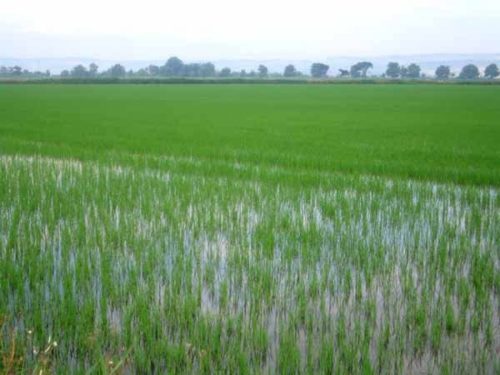
The second “pong” was soon behind us and the land became a bit drier. We came to a lonely house, where we crossed another canal and went around a low rocky knoll, which loomed as big as a mountain in this landscape.
Then we turned off on a rough dirt track, past an exotic looking flooded field of rice, and eventually found ourselves on another straight little road heading directly to the Canal de la Robine.
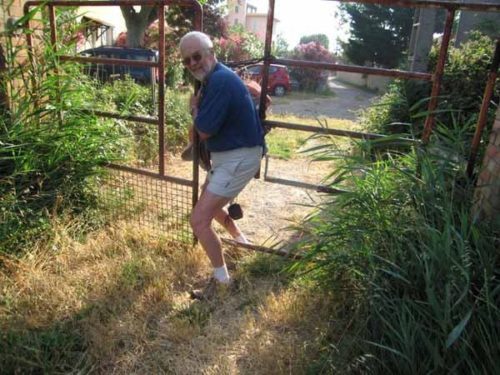
We reached it at a place called the Domaine du Petit Tournebel, which was an assembly of buildings half-hidden in flowering oleanders, red and pink, and dominated by a large square house with a hostile looking observation tower on the roof.
There did not seem to be anybody about, so we went around to the back, squeezed through a locked gate and emerged onto the towpath of the canal.

At this point we joined an official GR for the first time since entering St-Gilles. Actually it was a GRP (le Sentier du Golfe Antique), which circled the great lagoon adjoining Narbonne.
There was something reassuring about the sight of these red and yellow markers, even though we knew we had no chance of getting lost.
The canal, edged with reeds, snaked lazily between embankments which kept out the salt-infested marshes on either side, and the gravel path was shaded in places by stunted Mediterranean pines.

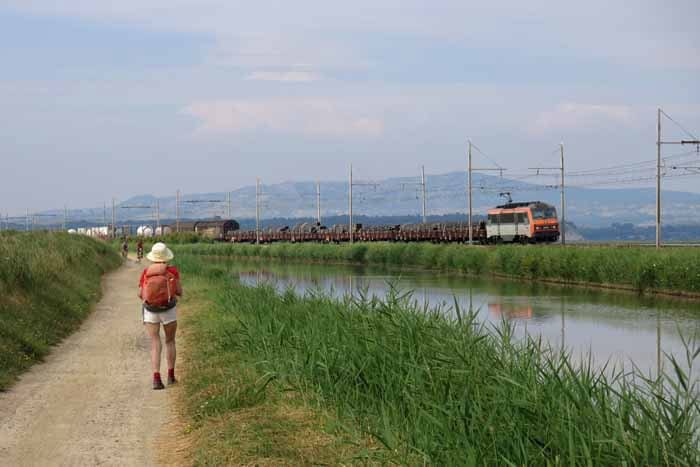
A few cyclists glided past and the still water of the canal was ruffled by the occasional pleasure boat, one of which was flying a Norwegian flag.
After a while the land outside the embankments shrank away and we found ourselves walking on a fresh-water thread across the salt lagoon, with only the railway line for company, and then even that peeled off. It was quite an odd sensation.
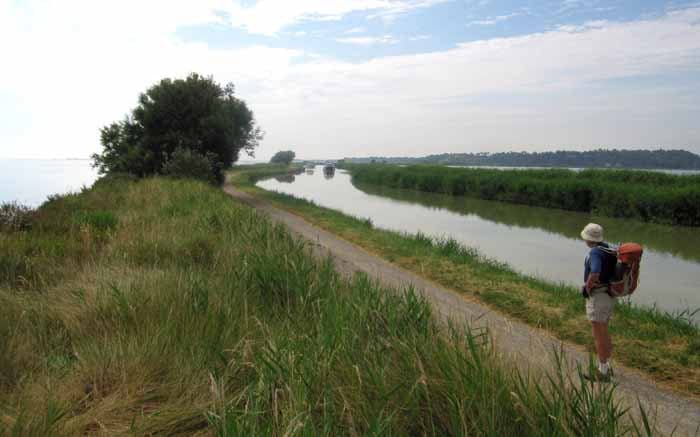
Far away we could see the chimney-stacks of Porte-la-Novelle, but the canal did not seem to go in that direction, it veered off towards a forested promontory and curved around the edge of it almost as far as the beach.
We passed the little settlement of Sainte-Lucie, after which the canal made a dramatic turn and plunged directly for the town.
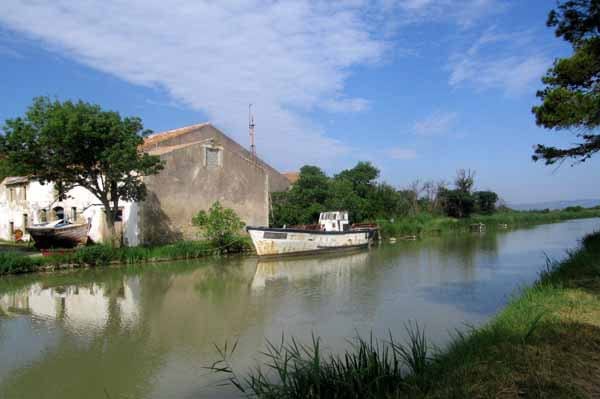
At the lock of Sainte-Lucie we saw the Norwegian boat stopped, unable to get through.
The occupants, so cool and elegant when they had glided past us, now looked flustered and one of them was shouting into a mobile phone. We waved slightly guiltily as we strode past.
The last stretch of the canal into the town was as straight as a ruler. The chimney-stacks that we had seen from afar turned out to be a big modern cement factory which used material brought down from the hillside opposite. From a distance it looked like a crashed jumbo jet, fifty times normal size.
Beyond the cement factory rose the ridge up which the next part of our walk would take us. It was a fearsome sight – brown and barren, shimmering in the heat haze. There was none of the exuberant greenery of summertime in France; indeed it looked more like outback Australia. Our hearts sank.
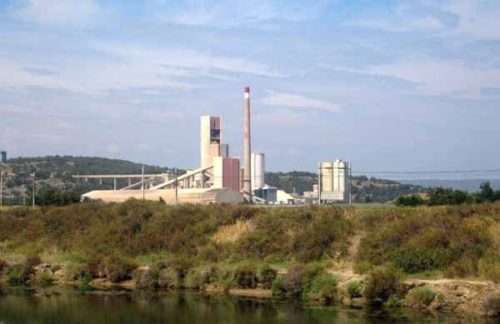
Having negotiated a huge new roundabout, we entered the town over a blue-painted steel bridge. It was a lively and picturesque scene, with pleasure boats moored six abreast along the canal next to a solid row of shops. Further along were the storage tanks and gantries of the real port, where ocean-going freighters were loaded.
Our first aim was to find a bar and it was not as easy as we expected, but we discovered one in the street behind the quay and settled down at an outside table looking onto a square.

The midday sun was now merciless and the café umbrella was not quite adequate against it, so we moved to another table under the dense shade of the building.
In doing so I left my camera behind, but the next occupants of the table, a couple of Dutch cyclists, found it and guessed that it belonged to us.
When she held it up questioningly, I thought she was asking me to photograph them, so I took it and started to compose the shot. Confusion reigned until I realised that it was my camera that I was holding.
Fortified by this break, we walked slowly through the scalding streets, which were as flat as a chess board, looking in vain for a sign to the camping ground. In desperation we went into a chemist’s shop where the kind white-coated pharmacist took us out to the street and pointed along past the sportsfield to where the camping entrance was visible. He also told us that there was a big supermarket just beyond that.

At the reception office, three bungling girls fell over each other to tell us all the rules – there were many – and managed to take our €13. We found a well-shaded spot surrounded by hedges and spread out our stuff on the dry, bleached grass.
Before settling in properly we went to the huge Super-U nearby and bought the makings of lunch. The air-conditioning inside was quite a treat.
After lunch we had showers and a little rest, but it was too hot to relax properly. Added to that, our minds were exercised with the problem of what to do next.
Our plan was to do the Cathar Way and we had the guide-book with us, although we had obviously not looked at it sufficiently before we set off.
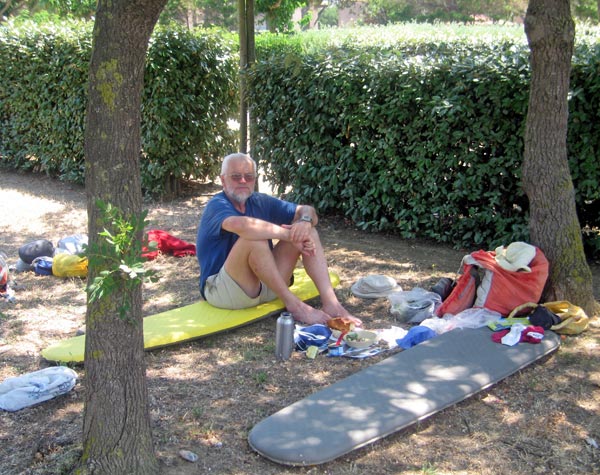
The description of the first day did nothing to dispel our doubts – it was 29 km of uphill slog with no water or shade, over dry limestone ridges. In April or September it may have been feasible, but in the middle of July it was another matter entirely.
We were often accused of being mad (by our friends), but we were not suicidal, and we did not think we could even carry the weight of water that we would need. The description of the following days did not sound much better.
Thus we relinquished our ambitions for the Cathar Way, and as we did so a great weight was lifted from our shoulders. The rest of France was just as hot as here, so there was no point in moving to another area.
Our walk was over for this year. There would be no more exertion in the sweltering sun, no more disappointments outside closed bars, no more parched and over-priced camping grounds. We would spend the remaining fortnight revisiting by train some of our favourite villages from previous trips, and only walking the bare minimum – from our tent to the local bar or restaurant, for instance.
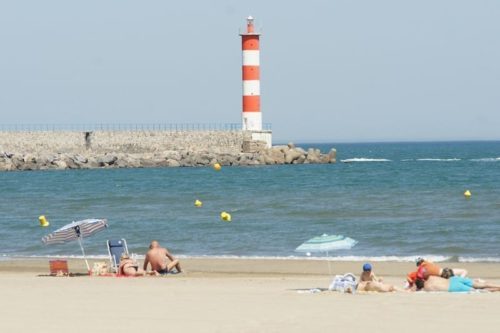
The rest of the day we spent exploring the town of Port-la-Nouvelle. At the end of the canal, where it disgorged into the Mediterranean, was a surprising sight – a whole separate metropolis of tourist mayhem along the hot, crowded, dreary strip that was the beach.
There were shops selling ice-cream, umbrellas, beach-balls, drinks, clothes, pizza, and behind them a tight mass of apartment blocks. The only attractive thing about it all was the striped lighthouse on the point, beyond the Office of Tourism.

Meanwhile, separated by a kilometre or more, the normal town continued its quiet life undisturbed. It was odd that in all this exploration we never saw another walker, even though Port-la-Nouvelle was the starting point of the Cathar Way and the guide book claimed that it was the most popular walk in France!
When the ferocity of the day started to mellow, we looked around for somewhere to dine and decided on the Hôtel du Port, a blue-painted establishment next to the blue bridge – we wondered whether there had been blue paint going cheaply after the bridge was finished.
What we liked about this place was that it was full of locals, all kissing each other as they came and went. The only upsetting element was the waitress’s thick mauve lipstick, outlined in scarlet, but we decided to rise above it.
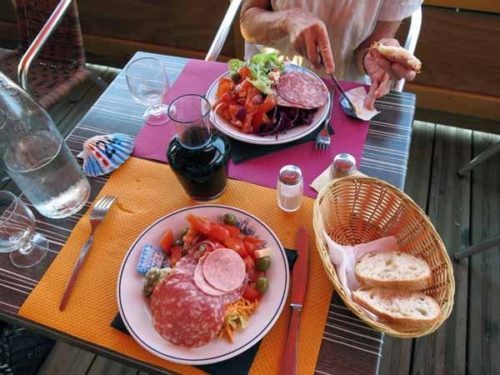
The tables were set on a small deck straddling the footpath, with a hectic orange plastic awning overhead. After leisurely apéritifs we started on the €13.50 menu, which began with a plate each of charcuterie and crudités.
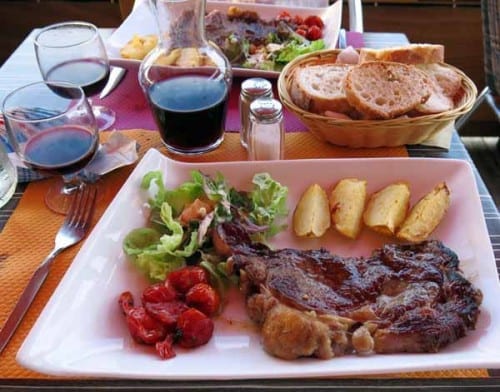
We shared these, then we both had big nourishing steaks with baked potato and more vegetables. Having polished off all the bread and wine, we moved on to dessert – crème caramel for Keith and a café crème for me. It was a satisfying and delightful dinner.
There was a festive air about this meal, as it celebrated the end of a monumental walking adventure, in which extremes of both cold and hot weather played their part.
Leaving Port-la-Nouvelle
Port-la-Nouvelle has a railway station. From there you can go to almost anywhere in France.
Postscript

The two weeks that followed were an exercise in keeping cool. Although we walked very little, we still suffered in the tremendous heat, especially in the long afternoons.
No matter how thick shade of the trees, the air was still roasting as we lay on the grass underneath. But the mornings and evenings were much more enjoyable.
The first thing we did was to take the little red tourist train up into the Pyrénées, to get a taste of what we were missing on the Cathar Way.

From the train we saw the ruined castles of Quéribus and Puylaurent, seeming almost part of the high grey crags on which they stood, and we thanked our lucky stars that we were not trudging up to them.
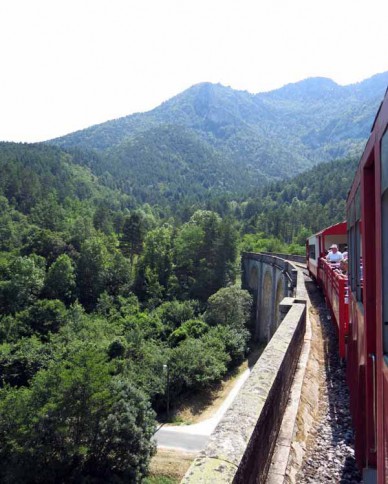

We imagined that it would be cooler up in the mountains, but we were wrong – at the village of Axat, the terminus of the train, we had never felt so hot in all our lives, and the only thing we could do was to sit on the grassy bank of the fast-flowing Aude river with our feet in the water until it was time to get back on board.

The next day we took the train to Bergerac and spent four nights at the camping ground on the banks of the Dordogne, where we had been twice before.
It was just across the bridge from the old town and we made the most of the delights of the cafés there, as well as joining in the Bastille Day parade and the fireworks on the river.
One afternoon in the town, as we sat under a vine with our coffee, we saw a weather sign announcing that it was 39ºC.
Our next destination was les Eyzies on the Vézère river.
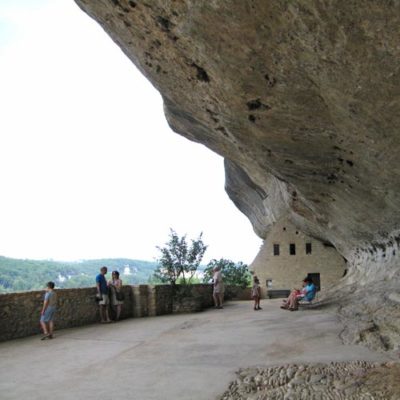
The camping ground had expanded slightly since our last visit. It was on the river flats and had a splendid restaurant and bar attached to the original farmhouse, as well as a pool.
There were plenty of interesting things to do, as les Eyzies is famous for its archaeological excavations. The rock shelters along the river were occupied by the earliest people to arrive in Europe, and it is still possible to imagine these ice-age settlements in full swing. There were also two fine museums of prehistory, both air-conditioned.
After three nights there, we caught the train to Périgueux, another place with fond memories for us, but we had forgotten how far out of town the camping ground was.
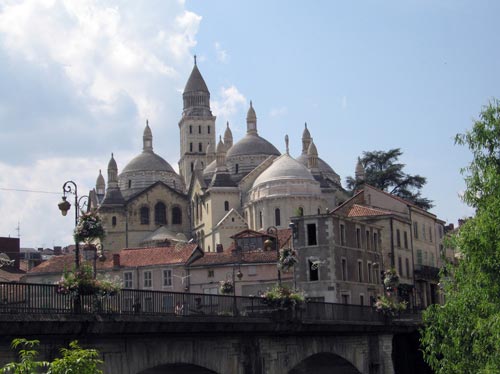
Having walked there from the station (a distance of nearly three kilometres up the river), we then had to retrace our steps to town and back in the crushing heat of the evening for dinner.
One night of this was enough, and the next day we pushed on up the line to Tours.
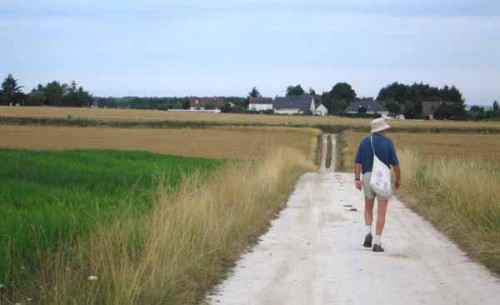
There is no camping in Tours, so we had the luxury of an air-conditioned hotel for the night, and a beautiful meal in the street nearby, at which we first tasted the local apéritif called Vouvray Pétillant.

Our next stop was at Bléré on the Cher river. The camping ground here is only two streets from the church square and full of large spreading trees.
We stayed here for three nights and did a few short walks in the nearby hills (as recommended by the Office of Tourism) in the early mornings, but by 10 am it was like a furnace.
Our final staging post was Selles-sur-Cher, a few stations further along the line from Bléré. Unfortunately, in the labyrinthine SNCF timetable, all trains that stop at Bléré do not stop again until far up the river.
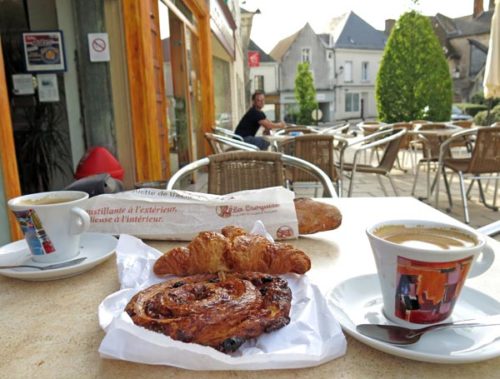
However, there are trains that bypass Bléré and stop at the next station (Chenonceaux), after which they stop at all stations.
In these circumstances we were obliged to walk the ten kilometres to Chenonceaux to continue our progress.
We started early and it was easy enough, but we were dripping with sweat when we arrived. The village of Chenonceaux is a drab little appendage to the tourist-ridden château, and we took the first train out.
Selles-sur-Cher, like Bléré, has a grassy, leafy camping ground very close to the centre of the village.

We thought of doing some of the little walks suggested by the Office of Tourism, but in the end we did nothing – it was too hot. We just lay on the grass in the shade, reading, or went to one of the bars in the village.
The highlight of all these lazy days was the morning coffee in the village square and the evening meals, which were uniformly delicious and interesting.
On the 28th of July we packed up for the last time and made our way to Paris, stopping at Vierzon to change trains. That evening we were in the air on our way home.
Previous day: St-Pierre-la-Mer to Gruissan